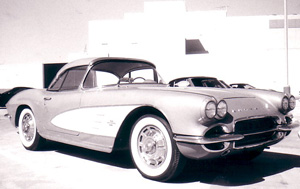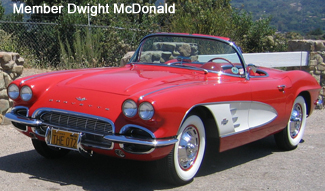
A more refined looking grille with thin, vertical and horizontal bars and a “duck-tail” rear end treatment with four cylindrical taillights made the new-for-1961 Corvette stand out. The overall design incorporated a hint of the soon-to-arrive ’63 Sting Ray.
For identification, the ’61 Corvette had a front badge with a crossed flag over a “V.” The rear emblem had a spun silver background with a similar crossed flags over a “V” design and the words “Chevrolet Corvette.”
The exhaust now exited under the car, rather than through bumper ports. Through-the-bumper exhaust systems looked cool but led to the rapid deterioration of chrome trim.
Standard Corvette equipment included: a tachometer; seat belts; sun visors; a dual exhaust system; carpeting; an electric clock, an outside rearview mirror, a lockable rear-seat storage area and a new aluminum radiator. A temperature-controlled radiator fan was also made standard.
The ’61 Corvette came in any of seven standard colors: No. 900 Tuxedo Black (Black or White top on convertible); No. 936 Ermine White (Black or White soft top); No. 923 Roman Red (Black or White soft top); No. 940 Sateen Silver (Black or White soft top); No. 912 Jewel Blue (Black or White soft top); No. 920 Fawn Beige (Black or White soft top) or No. 948 Honduras Maroon (Black or White soft top). To get the side indentation (cove) painted in a contrasting color cost $16.15 additional. This was the last year a contrasting color could be ordered from the factory for the side coves.
Black (Black or White top on convertible); No. 936 Ermine White (Black or White soft top); No. 923 Roman Red (Black or White soft top); No. 940 Sateen Silver (Black or White soft top); No. 912 Jewel Blue (Black or White soft top); No. 920 Fawn Beige (Black or White soft top) or No. 948 Honduras Maroon (Black or White soft top). To get the side indentation (cove) painted in a contrasting color cost $16.15 additional. This was the last year a contrasting color could be ordered from the factory for the side coves.
With a 102-inch wheelbase and 172.2-inch overall length, the Corvette wasn’t a big car. It stood 51.6 inches high and 72.8 inches wide. Front tread width was 57 inches and the rear was a bit wider at 58.8 inches. The road-hugging fiberglass sports car sat only six inches off the ground, even with big 6.70 x 15 tires mounted.
The “glass” body was bolted to a welded, steel box-section, X-braced frame which, unlike the body, could rust. For front suspension chores the Corvette used Independent; upper and lower A-arms with unequal-length wishbones, coil springs, an anti-roll bar and tubular shocks. At the rear was a hypoid semi-floating live axle with semi-elliptic leaf springs and tube shocks.
Chevrolet’s Saginaw re-circulating ball steering had a 17:1 ratio and required 3.7 turns lock-to-lock. The required turn circle was 38.5 feet. Four-wheel hydraulic, internal-expanding brakes with 11-inch diameter drums were used for stopping. The standard linings provided 157 square inches effective lining area, but only 121 square inches was needed with the factory-optional sintered metallic linings. In these pre-mag-wheel days, Corvettes had glittery-looking wheel covers on 15-inch steel bolt-on wheels.
Inside the car there were vinyl-upholstered bucket-type seats that came in Black, Red, Fawn or Blue. The only body style was the convertible, which listed for $3,934 and weighed 2,905 lbs. If you wanted a power-operated folding top mechanism the cost was $161.40 extra. An auxiliary hardtop cost $236.75 You could get both. A total of 10,939 Corvettes were built for 1961.
Five small-block V-8s were used in 1961 Corvettes. All of them were based on the 283-cid engine which had a 3.87 x 3.00-inch bore and stroke. The engine lineup looked like this: Base: 9.50:1 compression. 230 at 4800 rpm. Hydraulic lifters. Carter Type WCFB four-barrel carburetor. Optional:. 9.50:1 compression. 245 at 4800 rpm. Hydraulic lifters. Two four-barrel carburetors. Optional: 9.50:1 compression. 270. Hydraulic lifters. Two four-barrel carburetors. Optional: 11.00:1 compression. 275. Hydraulic lifters. Rochester fuel injection. Optional: 11.00:1 compression. 315 at 6200 rpm. Solid lifters. Rochester fuel injection.
If ultimate acceleration was your goal, a ‘61 Corvette with a 283-cid 315-hp solid-lifter fuel-injected V-8 and the 3.70:1 rear axle could go from 0-to-30 mph in 2.6 seconds; from 0-to-60 mph in 6.0 seconds and from 0-to-100 mph in 14.2 seconds. Such a car could do the quarter mile in 15.5 seconds at 106 mph and reach 140 mph. However, most ’61 Corvette buyers were happy to just cruise the highway, like the stars of Route 66, in a four-barrel sports car that outran just about anything they were likely to meet on the “Mother Road.”
’61 VETTE FACTS
|
|
|
VEHICLE IDENTIFICATION NUMBER
|
10867S100001 through 10867S110939
|
|
ENGINE
|
BASE ENGINE
Type: V-8
Bore and stroke: 3.87 x 3.00 in.
Displacement: 283 cid
Brake hp: 230 at 4800 rpm.
Carburetor: Carter Type WCFB 4-bbl
OPTIONAL ENGINES:
283-cid/245-hp w/ two 4-bbl. carb
283-cid/270-hp w/ two 4-bbl. carb
283-cid/275-hp w/ Rochester fuel
injection
|
|
VITAL STATS
|
Convertible
Original Price: $3.934
Production: 10,939
Wheelbase: 102 in.
Length: 177.2 in.
Tires: 6.70 x 15
|
|
COOL STUFF
|
• Windshield washers, courtesy light, sun shades, temperature-contolled radiator fan and parking brake warning light all became standard equipment.
|